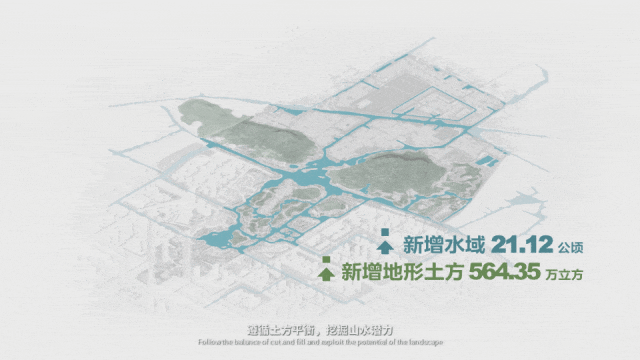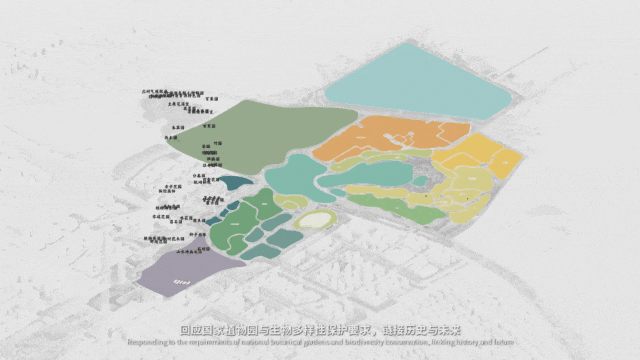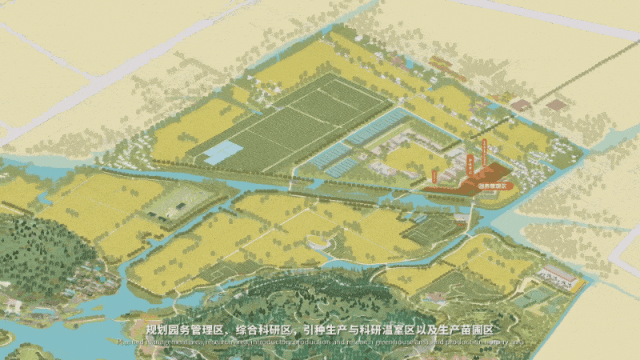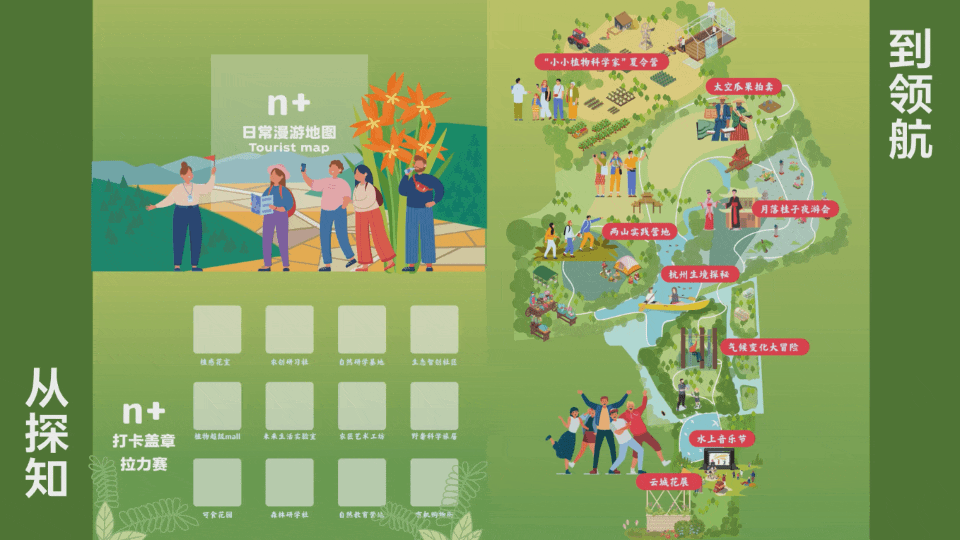本文由 MLA+亩加 授权mooool发表,欢迎转发,禁止以mooool编辑版本转载。
Thanks MLA+B.V. for authorizing the publication of the project on mooool. Text description provided by MLA+B.V..
MLA+亩加:当一座植物园,可以从都市核心高铁站月台脚不沾地10分钟步行直达;当一座植物园,占据都市CBD最金贵的、原本应做高密度TOD开发的核心地段;当一座植物园,有1.5倍纽约中央公园的大小,逐渐消解了园与城的边界……
我们应该怎样安排这样的雄心?又应该怎样定义新的园、新的城、新的城园关系?
2023年6-8月,多义景观、MLA+亩加与浙大院联合参加杭州市第二植物园(暂名)概念规划方案,这是一次具有独特意义的体验。488公顷的中轴植物园,能为一座城市带来什么?我们从城市、植物与多样性、社会责任、策划运营,多个维度出发,真诚与环境对话,与生活在当地的群体对话,以更加理性、温柔的设计,试图找到一种更加适宜未来城市发展的植物园模式与结构。
MLA+B.V.: When a botanical garden stands just a ten-minute walk from the heart of the urban core, accessible directly from the high-speed railway station platform. when a botanical garden claims the most prized location in the urban CBD, originally designated for high-density TOD development. when a botanical garden spans 1.5 times the size of New York’s Central Park, gradually blurring the boundaries between park and city…
How do we organize such ambition? How do we define a new park, a new city, a new relationship between the two?
From June to August 2023, ATELIER DYJG
, MLA+B.V., and UAD jointly participated in the conceptual planning of the Second Botanical Garden in Hangzhou (temporary name). This was a uniquely meaningful experience. What can a 488-hectare central axis botanical garden bring to a city? We engage in a sincere dialogue with the environment, focusing on urban, botanical and biodiversity aspects, social responsibility, planning and operation, interacting with local communities, striving for a more rational, gentle design. Through this approach, we aim to explore a botanical garden model and structure that better suits the future development of cities.
▽植物园鸟瞰 Aerial view of Botanical Garden

自然与城市一起做功,是自然加城 Nature and city working together, It’s nature plus city
一千个杭州人眼里,有一千种自然。疏浚西湖,圩田筑堤,是城市基础设施,也是人文山水走廊。
尊重自然,赋能自然,创新自然,是杭州从古至今与自然的相处之道,也是杭州市第二植物园将在云城延续的营城哲思。
In the eyes of a thousand Hangzhou residents, there are a thousand kinds of nature. Dredging West Lake, and constructing embankments for fields, are not just urban infrastructure but also cultural landscapes.
Respecting nature, empowering nature, and innovating with nature—this has been Hangzhou’s way of coexisting with nature from ancient times to the present. It’s also the philosophical thinking that the Second Botanical Garden of Hangzhou will continue to embrace in Yun City.
▽自然加城 Natural city

杭州第二植物园(简称“杭二植”)位于西站枢纽,占地488公顷,无论是在区位和体量上,在国内大型植物园中条件中均处于领先优势,具有强大后发力量。一个杰出的植物园应该具有完整的山水结构,既作为风景的骨架,也是生境的基底,融于城市,启发城市。
杭二植是新城的生态绿心、自然地标,城市生活的公共空间,也是新城发展的驱动引擎。设计跳出传统植物园模式,从城市框架、界面、产业、交通和全域生态出发,共谋植物园全生命周期。
是否体验过,搭乘云轨,空中穿梭森林与城市?在家附近逛逛新鲜植物的超级市场?每日骑行通勤途中,横跨竹林深吸一口清新空气?
在云城,植物园不再拥有明显的围栏和界限,设计将边界巧妙打开,城心“锚点”空间,亦是植物园的入口魅力场所,让自然资源与城市资源交叠,形成系列新业态模式,塑造多元的园城界面,每个入口都有专属的自然记忆。
The Second Botanical Garden of Hangzhou, is located at the West Station hub, occupying 488 hectares. It holds a leading advantage among large botanical gardens in China in terms of both location and size, showcasing strong potential for future development. An exceptional botanical garden should possess a complete landscape structure, serving as both the backbone of scenery and the foundation of habitats, seamlessly integrating with the city and inspiring urban life.The Second Botanical Garden of Hangzhou serves as the ecological green heart and natural landmark of the new city, a public space for urban life, and the driving engine for new city development. Its design breaks away from the traditional botanical garden model, aiming to encompass the entire lifecycle of the botanical garden from the urban framework, interfaces, industries, transportation, and holistic ecology.
Have you ever experienced riding the cloud rail, traversing between forests and the city in the air? Exploring a fresh plant supermarket near your home? Taking a daily bike commute, crossing bamboo groves, and deeply inhaling the fresh air?
In Yun City, the botanical garden no longer features distinct fences and boundaries. The design cleverly opens up its edges, creating pivotal spaces within the city that serve as attractive entrances to the botanical garden. This allows natural resources and urban assets to intersect, forming a range of new operational models, and shaping diverse interfaces between the garden and the city. Each entrance holds its unique natural memory.
▽无界嵌合,提供多元个性界面 Unbounded chimeric, provide multiple personality interface

▽植觉超级mall,衔接地铁与入口,亦是植物主题的超级市场 The Plant Sense Super mall, which connects the subway to the entrance, is also a plant-themed supermarket

强化自然体验的交通体系,3km绿轴、30+18km云城双环、50km+生境探索步道,水陆空多样抵达方式,成为居民主要的漫步途径,链接日常生活。全方位,多入口,享受出站即自然,绿色通达的自然枢纽。
Enhancing the transportation system for natural experiences, with a 3km green axis, a 30+18km dual-loop system in Yun City, and 50km+ habitat exploration trails. Offering various ways by water, land, and air for residents to reach, these become the primary walking routes, connecting to everyday life. A comprehensive, multi-entrance approach allows for stepping out of stations directly into nature—a natural hub with green connectivity.
▽公共交通与慢行网络规划 Public transport and slow travel network planning

▽强化自然体验的交通体系 A transportation system that enhances the experience of nature

▽无缝衔接通勤线路,手机扫码植物叶片,通勤途中解锁植物歌单 Seamless commuter lines, mobile phones scan plant leaves, and unlock plant songs during commuting

植物园功能策划与城市协作,系统梳理自然本底资源,最大化自然资本家底。自然深度融合创新产业,聚焦五类创新产品:科创、游乐、健康、生态、研学,创造5N产业交互生态圈,以园促城,让植物园破圈“造血”。
Botanical Garden Functional Planning and Urban Collaboration systematically organize natural resources, maximizing the natural capital foundation. Deep integration of nature drives innovative industries, focusing on five types of innovative products: scientific innovation, recreation, health, ecology, and educational research. Creating an interactive ecosystem for the 5N industry, the garden catalyzes the city, breaking boundaries to ‘generate’ vitality for the botanical garden.
▽融合自然与城市资源的业态策划 Business planning integrating natural and urban resources

▽植物园5N创新模式 Botanic garden 5N innovation model

▽生物多样性为基石构建自然资产网络,提升云城“自然资产” Biodiversity as the cornerstone to build a network of natural assets, enhance the Cloud City “natural assets”

万物栖息之所,山水生境之家,是自然家园 The dwelling of all beings, A home for landscapes and habitats, It’s the abode of nature
杭州的风景一方面源于以西湖为代表的秀美山水,另一方面也根植于基于农业传统而形成的圩田水网。
为使杭州市第二植物园在物种保育方面具有科学性、独特性及可行性,需要认清杭州的地理环境和气候条件,浓缩出区域典型的山、河、湖、渠、荡、田、城等生境类型,同时要关注植物园建设与省内各植物园、科研机构、高校以及企业的协同。
The scenic beauty of Hangzhou is not only represented by the picturesque landscapes, notably West Lake but also deeply rooted in the intricate network of paddy fields formed based on agricultural traditions.
To ensure scientific, distinctive, and feasible species conservation within the Second Botanical Garden of Hangzhou, it’s crucial to understand Hangzhou’s geographical and climatic conditions. It involves highlighting typical regional habitats like mountains, rivers, lakes, canals, wetlands, fields, and urban areas. Simultaneously, attention should be given to collaborative efforts between the botanical garden’s construction and various botanical gardens, research institutions, universities, and businesses within the province.
▽自然家园策略 Natural home strategy

杭二植设计详细地整理了区域寡山、吴山、河渠和池塘等地貌,塑造出地域特有的山水意境,提供丰富的生境类型,也营造功能各异、特色不同的游览空间。基于本底,延山引水,杭二植以全域视野和因地制宜的方式构建全园山水体系,形成一脉,两山,四组团,五主题体验区的园区结构。
The design of the Second Botanical Garden of Hangzhou meticulously organizes regional landscapes like Gu Shan, Wu Shan, rivers, canals, and ponds, creating a distinctive regional landscape and offering diverse habitat types. It not only shapes the unique artistic conception of landscapes but also provides varied touring spaces with different functionalities and characteristics. Building upon this foundation, leveraging the mountainous terrain and water resources, the Second Botanical Garden of Hangzhou constructs a comprehensive mountain and water system throughout the entire garden, creating a connected structure consisting of one main axis, two mountains, four clusters, and five themed experiential zones, all in harmony with the local conditions.
▽以两山为坐标,延山形成风景骨架与生境基底,实现城市与自然的互望联动 Taking the two mountains as coordinates, the Yanshan mountain forms the landscape skeleton and habitat base to realize the mutual looking linkage between the city and nature

▽通过延河、拓湖与织网,依托现状圩田骨架形成丰富的水生生境 Through Yan River, Tuohu lake and weaving nets, rich aquatic habitat is formed on the basis of the present polder skeleton

▽一脉,两山,四组团,五主题体验区的全园结构 One vein, two mountains, four groups, five theme experience area of the whole park structure

植物园适合引入哪些植物、多少植物,植物以什么展陈体系呈现给大众及专业人员,是项目极重要的课题。
明晰的科研目标,严谨的引种逻辑,未来运营主体的协同机制,均是建立国家植物园与生物多样性保护的必备前提。杭二植立足世界与浙江全域生境,收集中国中亚热带及东南沿海地区,全球亚热带季风气候区与北纬30度横贯特色气候带及植被类型,共筑36个专类园、4大温室与3大自然参与区,让科研人员对植物园有更加学科体系的把控; 5大主题区,以由浅至深的体验方式呈现给游客市民,推动全龄网络的自然教育与美育体系。
Determining which plants and how many should be introduced into the botanical garden, as well as the exhibition system for presenting these plants to the general public and professionals, is a highly critical aspect of the project.
Clear research objectives, a rigorous introduction logic, and a coordinated mechanism for future operations are all essential prerequisites for establishing a national botanical garden and biodiversity conservation. Based on global and Zhejiang regional habitats, the Second Botanical Garden of Hangzhou gathers plant species from China’s central subtropical and southeast coastal areas, and the global subtropical monsoon climate zones, spanning the unique climate belts and vegetation types along the 30th parallel north. It constructs 36 specialized gardens, 4 large greenhouses, and 3 natural participation zones, providing researchers with more systematic control over the botanical garden. Additionally, the 5 major thematic areas are presented to visitors and citizens in a progressively immersive manner, fostering a comprehensive nature education and aesthetic system for all age groups.
▽33类生境斑块形成包含36个专类园、4大主题温室与3大自然参与区的自然栖息天堂 33 types of habitat patches are formed, including 36 special parks, 4 themed greenhouses and 3 natural habitat paradise

▽植物展陈体系梳理 Plant display system combing

针对具有示范性的专类园,设计团队提出明确科研团队与目标方向,提升植物力量的未来可实施性。
For the exemplary specialized gardens, the design team proposes clear research team objectives and directions to enhance the future feasibility of harnessing the botanical power.
▽植物体系回应国家植物园和生物多样性的要求 The plant system responds to the requirements of the National Botanical Garden and biodiversity

南区为到达第一站,大众的第一印象,着重激发兴趣,展陈体系具象、可感知、体验互动性高,全天候的活动,是自然创新展示平台,集聚自然品牌,创新成果无缝对接市场,加速市场响应与科研转化。
The southern area serves as the first stop, the public’s initial impression, focusing on sparking interest. The exhibition system emphasizes concreteness, perceptibility, and high interactivity for experiences. It’s an all-weather platform for innovative natural displays, gathering natural brands, seamlessly connecting innovative outcomes to the market, accelerating market response, and scientific research transformation.
▽植感花室,梦境般的花宇宙,定期举办各式花展 Plant sense flower room, dreamlike flower universe, regularly hold a variety of flower shows

▽深植回廊,无限循环,夜间奇幻的数字森林 Deeply planted cloisters, infinite loops, a digital forest of night fantasy

▽植物游乐园,驾驶种子飞车,划起榛果小船,宝藏路线带你上天入水,打开植物盲盒 Plant amusement park, drive the seed flying car, row the hazelnut boat, treasure route to take you to the water, open the plant blind box

进一步探索,走向树木园与主温室,植物展陈开展全局系统化的认知,植物展陈超越过往熟知的分门别类,更具未来性地应对全球未来气候变化和可持续发展的研究进行针对性引种,详细说明其植物体系、科研目标与特有品种,与世界同气候带代表性植物关联,完善科研与科普知识体系。
Further exploration leads to the arboretum and main greenhouse, systematically broadening the cognition of plant exhibitions. These exhibitions transcend the traditional classifications, offering a more futuristic approach to addressing global climate change and sustainable development. Specifically, targeted introductions of plant species are explained in detail regarding their botanical systems, research objectives, and unique varieties. These are correlated with representative plants from similar climate zones worldwide, enhancing the knowledge system in both research and public education.
▽应对全球气候变化的“浙木园”与“全球引种园””Zhemu Garden” and “Global Introduction Garden” in Response to Global Climate Change

▽树木园提出应对气候挑战引种计划 Arboretum proposes introduction plan to cope with climate challenge

以杭州为坐标原点,温室着重与北纬30度和亚热带季风气候区域内的众多优秀植物园交换引种、建立合作,助力全球亚热带及同纬度地区的植物保育、科学研究和知识传播。温室由热带温室、沙漠温室、地中海花园及高山冷室组成,以植物视角揭秘地球最神秘的地带,用自然语汇讲述文明古国的传奇。
With Hangzhou as the coordinate origin, the greenhouse focuses on exchanging and collaborating with numerous excellent botanical gardens within the 30th parallel north and subtropical monsoon climate regions. This effort aims to support plant conservation, scientific research, and knowledge dissemination for subtropical and similar latitude areas globally. The greenhouse comprises tropical, desert, Mediterranean gardens, and alpine cold chambers. It unveils the most enigmatic zones of the Earth from a botanical perspective, narrating the legends of ancient civilizations using the language of nature.
▽主温室收集北纬30度横贯特色气候带及植被类型 The main greenhouse is a collection of 30 degrees north latitude across characteristic climatic zones and vegetation types

植物园中部吴山、寡山,是现状最具杭派山水基因的区域,有着强烈美学特征和地域历史文脉。我们以宋画的山水韵律与楼阁秩序为基础,透过山水比例的构成关系,充分与现状地貌结合,形成该区的风貌基调。
The central parts of the botanical garden, Wu Shan and Gu Shan, embody the most characteristic landscape genes of Hangzhou’s current state, displaying strong aesthetic features and the historical context of the region. We base our design on the landscape rhythm of Song Dynasty paintings and the architectural order of pavilions. Through the compositional relationships within the landscape proportions, we thoroughly integrate them with the current topography to establish the overall character of this area.
▽依托宋画的山水韵律与楼阁秩序,形成两山画卷 Relying on the rhythm of landscape painting and the order of pavilions in Song Dynasty, the two mountain scrolls are formed

四时花木园,诉说春堤、夏荷、秋林、冬山的四季轮回。
Four Seasons Botanical Garden narrates the cyclical journey of Spring Banks, Summer Lotus, Autumn Forests, and Winter Mountains.
▽两山区域,山体地形被充分保护和优化 In the two mountain areas, the mountain topography is fully protected and optimized

▽讲述植物演化历史的分类园 A classified garden that tells the history of plant evolution

遵循APG4分类系统,分类园讲述着植物漫长的演化历史。杭州瑰宝区汇聚代表物种,协同优势科研力量,并重点建设木樨、竹、绣球3个精品专类园。利用现状绿丘与溪流栖息地优势,营建荫生花园、水花园、岩石花园等展现浙江全域生境特色的全栖生境区。
Following the APG4 classification system, the classified gardens narrate the extensive evolutionary history of plants. The Hangzhou Treasure Area gathers representative species, harnesses collaborative research strengths, and focuses on developing three premium specialized gardens dedicated to Osmanthus, Bamboo, and Hydrangea. Leveraging the advantageous habitats of existing green hills and streamside habitats, we construct shade gardens, water gardens, rock gardens, and more to showcase the characteristics of Zhejiang’s regional habitats in the all-encompassing habitat zone.
▽杭州特色植物瑰宝的专类园区域 Special garden area of Hangzhou characteristic plant treasures

我们保护了吴山前村的区域肌理,梳理村落街巷空间结构,更新旧工厂及部分民居,植入生态触媒型集群,多方合作建立“两山自然保护基金”信托,以研、修、育、创,订制全龄友好的自然教育课程体系与环保公益社群,体验完整生态反哺链。
We preserved the regional texture of the former village at Wu Shan, organized the spatial structure of the village streets and alleys, renovated old factories and some residences, and integrated eco-catalyst clusters. Through multi-party collaborations, we established the “Two Mountains Nature Conservation Fund” trust, focusing on research, restoration, nurturing, and innovation. We tailored an all-age-friendly natural education curriculum and an environmental protection community, enabling a complete ecological feedback loop through experiential learning.
▽吴山前村,改造后的自然学校 Wushanqian Village, after the transformation of the nature school

▽森林研学提供多元化,全龄段的活动增强植物园吸引力 Forest studies offers a variety of activities across all ages to enhance the attraction of the Botanic Gardens

▽全周期、可持续的绿废处理 Full cycle, sustainable green waste treatment

植物园北,是适配全周期的植物科创科研区。规划支持首席植物科学家团队长期引进计划,提供综合科研区,引种生产与科研温室区、生产苗圃区,模块化布局科学家实践中心。周边村落升级公共服务系统,引入植物科创小院。无论是顶级植物学家,初出茅庐的青年学者,还是热爱植物的民间爱好者,都能在这里实现植物梦想。
North of the botanical garden is the all-inclusive Plant Science and Innovation Research Zone. The plan supports the long-term recruitment of chief plant scientists, providing a comprehensive research area, areas for plant introduction and research greenhouses, as well as a production nursery zone, with a modular layout for scientist practice centers. Surrounding villages will see upgrades in public service systems, introducing plant science and innovation cottages. Whether top-tier botanists, emerging young scholars, or plant enthusiasts, all can realize their botanical dreams in this environment.
▽植物科创科研及管理区 Plant science and innovation research and management area

▽北侧“大食物观”的杭州探索,支持长三角地区特色农业作物展示与科研 The Hangzhou exploration of the “Big Food Concept” on the north side supports the demonstration and scientific research of characteristic agricultural crops in the Yangtze River Delta region

▽种子仓库,保障种质安全和开展农业科普的场所 Seed warehouse is a place to ensure germplasm safety and carry out agricultural science popularization

永续运营,创造可被带走的自然记忆,是自然嘉奖。Sustainable operation, Creating portable memories of nature, Is nature’s commendation.
前置策划运营于开发建设,植物园建设运营联动园城,从分期建设、活动运营、品牌策划、财务平衡维度切入,共谋植物园全生命周期。项目详细回应云城建设重要建设计划,落实到各产品的实施时间轴。5N交互生态圈提供跨界产品和独特衍生服务,让不同业态在空间上实现交融,带动消费升级与投资,并提出相应的品牌、运营与租赁策略,推动未来经济可持续。
Pre-planning operations are essential for the development and construction of the botanical garden, linking its operations with the garden city. This involves phased construction, event operations, brand planning, and financial balance considerations, all aiming to envision the entire lifecycle of the botanical garden. The project aligns meticulously with the significant construction plans for Yun City, implementing detailed timelines for each product. The 5N interactive ecosystem provides cross-boundary products and unique derivative services, facilitating the convergence of different industries in space, driving consumption upgrades and investments. Corresponding strategies in branding, operations, and leasing are proposed to promote future economic sustainability.
▽自然嘉奖策略 Natural reward strategy

▽联动景点与绿色低碳行动 Linkage attractions and green low-carbon action

植物园的每个特色景点,均有专属的数字印章,联动景点与低碳行动,鼓励大众完成自然任务,获取独一无二的植物园印记与体验。植物园也为各类国际赛事的提供举办场所,结合推广和文化活动,持续造浓全民参与。
Each distinctive attraction within the botanical garden has its exclusive digital stamp, interconnected with the site and low-carbon actions, encouraging the public to complete natural tasks to obtain unique botanical garden imprints and experiences. The botanical garden also serves as a venue for various international events, combining promotion with cultural activities, and continuously engaging the public.
▽植物园打卡盖章行动 Botanical Garden punch stamp operation

▽连接城市、乡野与自然的杭州市第二植物园 Hangzhou Second Botanical Garden connects city, countryside and nature

项目名称:杭州市第二植物园(暂名)概念规划方案
项目类型:488公顷植物园设计,含城市设计、景观设计与建筑设计
项目地点:杭州云城
业主单位:
杭州市园林文物局
杭州市规划和自然资源局
杭州云城建设管理指挥部
杭州市余杭区人民政府
杭州市交通投资集团有限公司
方案状态:竞赛荣誉奖
设计联合体:
ATELIER DYJG北京多义景观规划设计事务所
MLA+亩加建筑规划(深圳)有限公司
UAD浙江大学建筑设计研究院有限公司
Project Name:Hangzhou Second Botanical Garden (Temporary Name)Conceptual Planning Scheme
Project Location: Yun City, Hangzhou
Project Type:488 hectares botanical garden design including urban design, landscape design, and architectural design
Owner:
Hangzhou Municipal Bureau of garden and cultural relics
Hangzhou Bureau of Planning and Natural Resources
Hangzhou Yun City Construction Management Command Office
Yuhang District People’s Government of Hangzhou
Hangzhou Transportation Investment Group Co., Ltd.
Scheme Status: Competition Honor Award
Team:
ATELIER DYJG
MLA+B.V.
The Architectural Design&Research Institute of Zhejiang University Co.,Ltd.
“ 与环境对话,与生活在当地的群体对话,以更加理性、温柔的设计,试图找到一种更加适宜未来城市发展的植物园模式与结构。”
审稿编辑:Maggie
更多 Read more about: MLA+亩加建筑规划




0 Comments